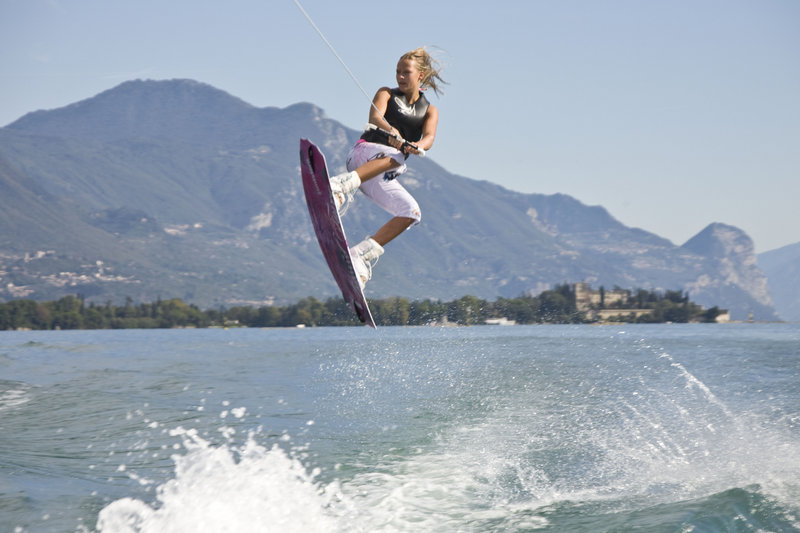
The Basics
Getting started is easy if you follow these simple steps. Have the right equipment, the latest pro board is not always the best to learn with. Give yourself a chance and get a board that is forgiving & helps you to progress. A larger board with one or more large rear fins helps to give the board direction which is important when learning.
A shorter rope - about 15 meters (50') gets you closer to the boat in a bigger wake, this will be helpful for learning to wakeboard, you can find more information on ropes and handles here. A buoyancy vest is not only basic safety equipment but it will also save you a lot of energy. The driver should remember that you need a lot less speed to get going and to stay planing than water skiing. 35-40 kph max. A wakeboard offers more resistance when starting, so start slowly!
Stance
(how and where you stand on your board). Your first step is determining whether you are regular (left-foot-forward) or goofy (right-foot-forward) . For those of you who skateboard or snowboard, this is easy. lf this is your first board sport, don't panic. Stand up, feet together and have someone push you from behind (sorry - on land). Whichever foot goes forward first is your lead foot.
Bindings Placement
Riders just getting started should try placing the bindings at about shoulder-width with the rear foot slightly farther back (closer to the rear fin) to aid with directional stability. The angle of your bindings is important. Start with the rear foot straight across the board (O degrees) or slightly forward to 9 degrees (one set of holes in the base plate). Your front foot should be at an angle of 9-27 degrees (2-3 sets of holes) to get started. Remember that this is just a guide and that your stance should feel comfortable. Keep in mind, however, that one of your first goals is going to be to ride revert (backwards). For this you will want something closer to neutral (0 / 0 degree) stance. tip: Before you get started, double-check the security of your fins and bindings. Do this every time you hit the water. You should even periodically check them during your ride after a fall.
The Deep Water Start
Start in the water, floating on your back with a buoyancy vest. The board should be perpendicular to the rope with your arms either side of your front knee . Signal the driver to put the boat just in gear. As you are pulled slowly forward, the pressure against the board will allow you to get into the proper starting position with most of the board below the surface of the water. Let the pressure on the board push your knees into your chest, then push your front foot forward toward the boat. Signal the driver to hit it and remain in a crouched position. As the boat begins to go, keep your arms slightly bent in near your lower stomach. Shift your weight toward the front foot while keeping the nose above the water. As the water begins to give you support, slowly rise to the standing position by extending your legs until your knees are slightly bent.
Once you're up, get comfortable on your board with slightly more weight on your rear foot. Let your hips and shoulders turn away from the boat. Riders with a skiing background have a tendency to try to face the boat this will often lead to a face plant as they catch or drop their front edge. Practice getting comfortable in the sideways position and relax. The key to the deepwater start is letting the boat do the work. Stay down low and stand up slow!
Remember
Set up perpendicular TO THE LINE floating on your back. As you start - Compress. LEAD WITH THE FRONT FOOT AND Let the line pull you up on the board. It is one continuous flowing motion and you should not be dragged through the water for long. Compress and stand up straight away. There is no harm in being up before fully planing.
The Switchstance Start
(Riding 'fakie', 'revert' or backwards) should be learnt as soon as possible. Most riders find it easier to start normal, then push the board to revert as soon as the board starts to plane off. Once this is mastered, you can go to a more direct approach by altenating your front foot every time you start. Don't wait to learn to ride switchstance; you'll need it for many tricks.
Crossing the Wake
Is easy if you approach it slowly at first with knees bent. The faster you go the more you need to 'suck it up' with your legs if you do not want to jump.
Jumping the Wake
Is easy. Compress just as you approach. As the wake lifts the board extend your legs and body. It is important to stay cantered over the board. On landing let your legs absorb the impact. The key to getting good height in your jumps is to edge ALL THE WAY through the wake. A common problem is to ease up the pull on the rope as you approach the wake and flatten out the board loosing critical energy which lifts you into the air. Loading or stretching the line primes it with the energy which 'pops' you into the air. Cut hard and late.


